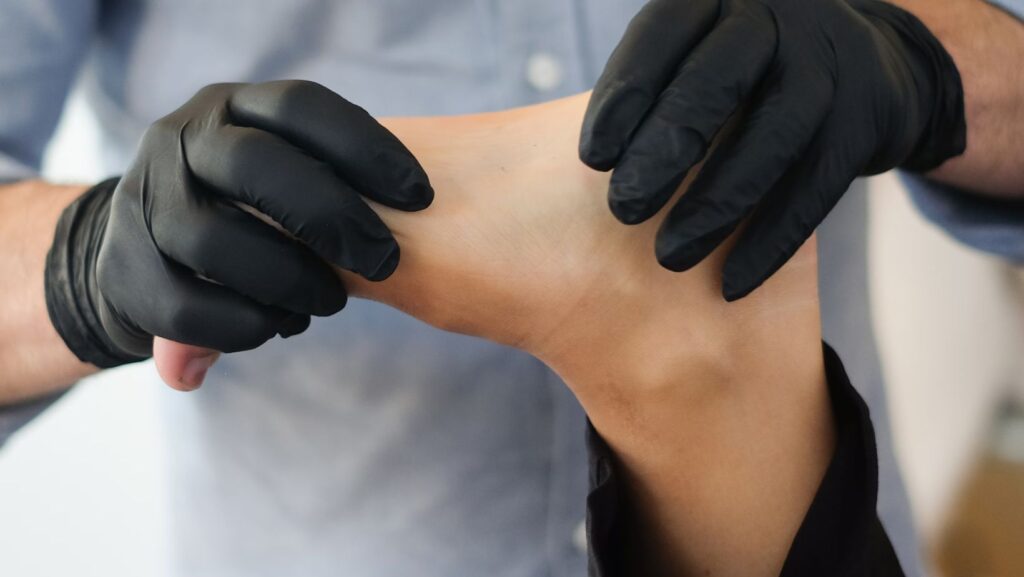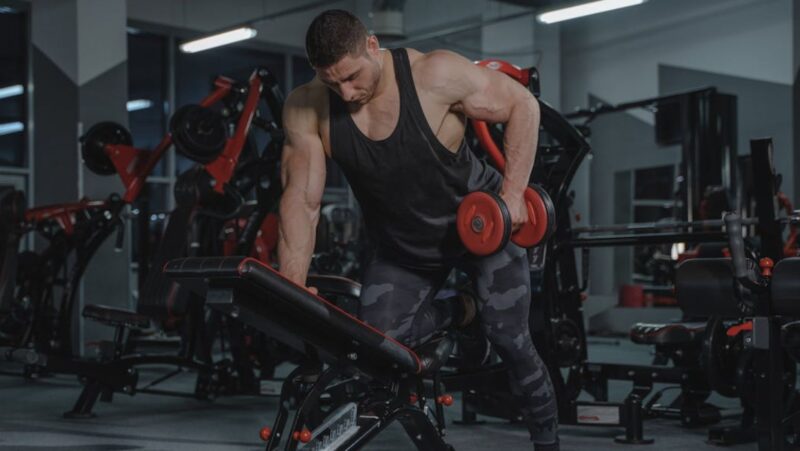
Ankle injuries are common, impacting individuals of all ages and activity levels. Understanding the anatomy of the ankle is crucial in comprehending the mechanisms of injury and implementing effective treatment strategies. This comprehensive guide aims to delve into the intricate structures of the ankle, explore various types of ankle injuries, and discuss their management.
The Anatomy Of The Ankle
The ankle is a complex joint connecting the leg to the foot and is crucial for mobility. It consists of three bones: the tibia (shinbone), fibula, and talus. The tibia and fibula bones comprise the lower leg, while the talus sits at the top of the foot. These three bones intersect to form the ankle joint, which allows up-and-down foot motion.
Several strong ligaments hold the ankle bones together and provide stability. On the inner side is the deltoid ligament, while on the outer side are three lateral ligaments: the anterior talofibular, calcaneofibular, and posterior talofibular ligaments. These ligaments can become stretched or torn, resulting in ankle sprains. The ankle joint is also stabilized by various tendons surrounding it and connecting to the lower leg and foot muscles.
Common Ankle Injuries And Their Causes
Ankle injuries often occur due to excessive stretching or twisting of the joint. Sports like basketball, tennis, and soccer that require a lot of jumping, pivoting, and side-to-side movement put the ankle joint at high risk. Rolled ankles are among the most frequent sports injuries caused by an awkward step with forced inversion or ‘rolling’ of the ankle outward. Most cases involve stretching or tears of the lateral ankle ligaments. You can learn more on websites such as Tetonfootandankle.com for information on ankle injuries.
Ankle sprains are graded 1 to 3 depending on severity. Grade 1 is mild stretching of the ligaments, grade 2 involves partial tearing, and grade 3 is a complete tear or rupture. Symptoms include pain, swelling, bruising, and instability of the ankle. Immediate treatment involves rest, ice, compression, and elevation. Bracing and physical therapy stabilize the injury and strengthen the muscles during recovery. Depending on the severity, crutches may be needed to avoid bearing weight on the injured ankle.
Chronic ankle instability can occur after repeated ankle sprains. The ligaments never heal completely, leading to recurrent ‘rolling’ of the ankle during activity. Custom ankle braces, balance training, and even surgery may be needed to tighten stretched ligaments.
Other ankle injuries, like fractures of the ankle bones, require casting or surgery. High ankle sprains involve injury of the syndesmotic ligaments higher up between the tibia and fibula. Achilles tendon injuries are also common in athletes and middle-aged people. The Achilles tendon attaches at the back of the heel and can rupture or develop tendinitis due to overuse.
Management Of Ankle Injuries
Effective management of ankle injuries encompasses a multifaceted approach tailored to the specific type and severity of the injury. Whether dealing with a mild sprain or a complex fracture, prompt and appropriate intervention is essential to optimize recovery and prevent long-term complications. Here’s a detailed look at the various aspects of ankle injury management:
- Initial assessment and diagnosis: The first step in managing an ankle injury is a thorough clinical assessment, which includes evaluating the mechanism of injury, assessing pain and swelling, and conducting a physical examination.
Diagnostic imaging—such as X-rays, ultrasound, or MRI scans—may be ordered to confirm the diagnosis and assess the extent of soft tissue damage or bony involvement.
- Acute phase management: For mild to moderate ankle sprains, initial management often involves the RICE protocol: Rest, Ice, Compression, and Elevation. This helps reduce pain and swelling, as well as promote healing.
Nonsteroidal anti-inflammatory drugs (NSAIDs) may be prescribed to alleviate pain and inflammation during the acute phase of injury.
Immobilization with a brace, splint, or walking boot may be necessary for more severe sprains or fractures to protect the injured ankle and facilitate healing.
- Rehabilitation and physical therapy: Once the acute symptoms subside, rehabilitation and physical therapy play a crucial role in restoring strength, flexibility, and function to the injured ankle.
Rehabilitation programs typically include exercises to improve range of motion, strengthen the muscles surrounding the ankle, and enhance proprioception and balance.
Progression through rehabilitation stages is guided by the individual’s response to treatment and functional goals to return to pre-injury activities safely and efficiently.
- Manual therapy and modalities: Manual therapy techniques—such as joint mobilizations, soft tissue massage, and proprioceptive neuromuscular facilitation (PNF) stretching—may be utilized to address joint stiffness and muscle tightness.
Modalities such as ultrasound, electrical stimulation, and laser therapy may be adjuncts to promote tissue healing, reduce pain, and improve circulation.
- Bracing and orthotics: Depending on the nature of the injury and individual biomechanics, custom orthotics or ankle braces may be prescribed to provide additional support and stability during rehabilitation and return to activity.
Ankle braces can help prevent recurrent sprains and offer external support to weakened or unstable ankle joints, particularly in athletes or individuals with chronic instability.
- Surgical intervention: In cases of severe ankle fractures, ligament tears, or tendon ruptures, surgical intervention may be necessary to realign fractured bones, repair damaged ligaments, or reconstruct torn tendons.
Surgical options vary depending on the injury and may include open reduction and internal fixation (ORIF), arthroscopic debridement, ligament reconstruction, or tendon repair.
Functional Rehabilitation And Return To Activity
As rehabilitation progresses, functional exercises focusing on sport-specific movements, agility, and proprioceptive training are incorporated to prepare the individual for a safe return to activity. Gradual progression of activity intensity and duration, along with ongoing monitoring of symptoms and functional performance, is essential to minimize re-injury risk and optimize long-term outcomes.
Injury Prevention Strategies
Once the individual has recovered from the ankle injury, implementing injury prevention strategies becomes paramount to reduce the risk of future injuries.
- Neuromuscular training: Neuromuscular training programs focus on enhancing muscle strength, balance, proprioception, and coordination. These programs often include dynamic exercises that mimic sport-specific movements and challenge the ankle joint in various planes of motion. By improving neuromuscular control, athletes can better adapt to sudden changes in direction and reduce the risk of ankle injuries.
- Proprioceptive exercises: Proprioception, the body’s ability to sense joint position and movement, plays a crucial role in ankle stability and injury prevention. Proprioceptive exercises—such as balance and stability drills, proprioceptive neuromuscular facilitation (PNF) techniques, and wobble board exercises—help improve proprioceptive awareness and joint proprioception. These exercises challenge the ankle’s sensory feedback mechanisms, enhancing its ability to detect and respond to perturbations in balance, thereby reducing the risk of injury.
- Proper warm-up and cool-down routines: Adequate warm-up and cool-down routines are essential for preparing the body for physical activity and aiding in recovery afterward. A comprehensive warm-up should include dynamic stretching, mobility exercises, and sport-specific drills to increase blood flow, improve muscle flexibility, and enhance joint mobility. Similarly, cooling down with static stretching, foam rolling, and gentle cardiovascular exercise helps promote muscle relaxation, reduce muscle soreness, and prevent stiffness after activity.
- Footwear selection: Proper footwear is crucial for supporting the foot and ankle during physical activity and minimizing the risk of injury. Athletes should choose footwear that provides adequate cushioning, stability, and support for their sport or activity. Shoes with a firm heel counter, arch support, and a well-cushioned midsole can help distribute forces more evenly and reduce the risk of excessive pronation or supination, which can predispose individuals to ankle injuries.
- Environmental modifications: Environmental factors, such as playing surface characteristics and equipment design, can influence the risk of ankle injuries. Athletes should be aware of hazards on playing surfaces, such as uneven terrain, debris, or slippery conditions, and take precautions to minimize injury risk. Additionally, ensuring proper equipment maintenance and using protective gear, such as ankle braces or tape, can provide added support and reduce the likelihood of injury during high-risk activities.
- Education and awareness: Educating athletes, coaches, parents, and healthcare professionals about ankle injury prevention is essential for promoting a safe sports environment. Athletes should be taught proper landing and cutting techniques and strategies for recognizing early signs of fatigue or overuse. Coaches and trainers are critical in supervising training sessions, implementing injury prevention programs, and promoting safe playing practices to minimize the risk of ankle injuries.
- Regular conditioning and strength training: Maintaining overall physical fitness and lower extremity strength is critical to reducing the risk of ankle injuries. Standard conditioning and strength training programs should focus on strengthening the muscles surrounding the ankle joint, including the calf muscles, personals, and tibialis anterior. Exercises such as calf raises, ankle dorsiflexion and plantarflexion exercises, and resistance band exercises can help improve muscle strength and resilience, reducing the likelihood of injury during sports and physical activities.
- Monitoring and risk assessment: Athletes, coaches, and healthcare providers should monitor training loads, fatigue levels, and injury history to identify individuals at higher risk of ankle injuries. Implementing screening tools—such as the Functional Movement Screen (FMS) or the Star Excursion Balance Test (SEBT)—can help assess movement patterns, balance deficits, and asymmetries that may predispose individuals to injury. By identifying and addressing potential risk factors early, proactive measures can be taken to reduce the likelihood of ankle injuries and optimize athletic performance.
Rehabilitation And Beyond
Rehabilitation following an ankle injury is a crucial component of the recovery process. Physical therapy interventions focus on improving range of motion, strength, proprioception, and functional mobility. Progressive exercises targeting balance, agility, and coordination help restore standard ankle mechanics and reduce the risk of re-injury.
Proprioceptive training and neuromuscular re-education may be particularly beneficial for chronic ankle instability or recurrent sprains. These exercises aim to enhance sensory feedback and motor control, improve joint stability, and reduce the likelihood of future injuries.
Additionally, advanced rehabilitation techniques, such as aquatic therapy or dynamic balance training, can provide alternative modalities for individuals with persistent ankle dysfunction. Custom orthotics or bracing may also be prescribed to provide additional support and address biomechanical abnormalities contributing to ankle instability.
Conclusion
Ankle injuries are complex and multifaceted, involving various anatomical structures and mechanisms of injury. By understanding the intricate anatomy of the ankle joint, recognizing different types of injuries, and implementing comprehensive management and prevention strategies, individuals can effectively reduce their risk of ankle trauma and promote long-term joint health and function. Continued research and education are essential in advancing our understanding of ankle injuries and optimizing treatment outcomes for individuals across all age groups and activity levels.














